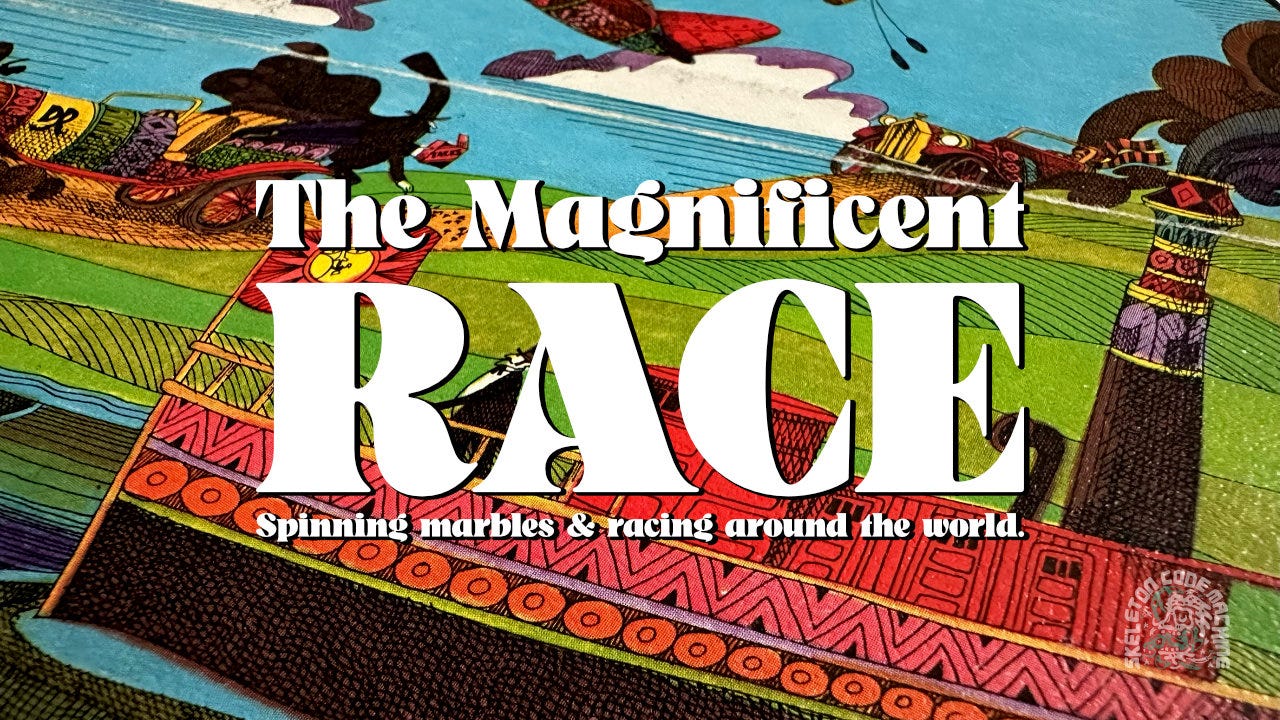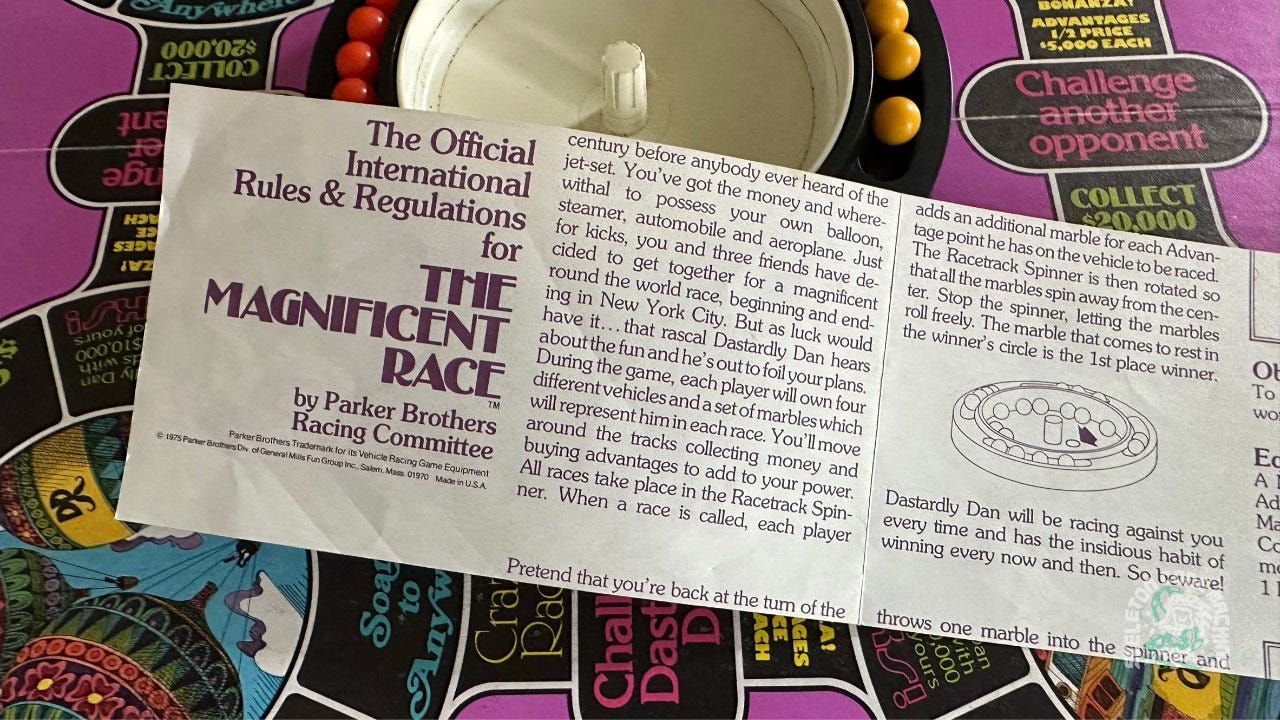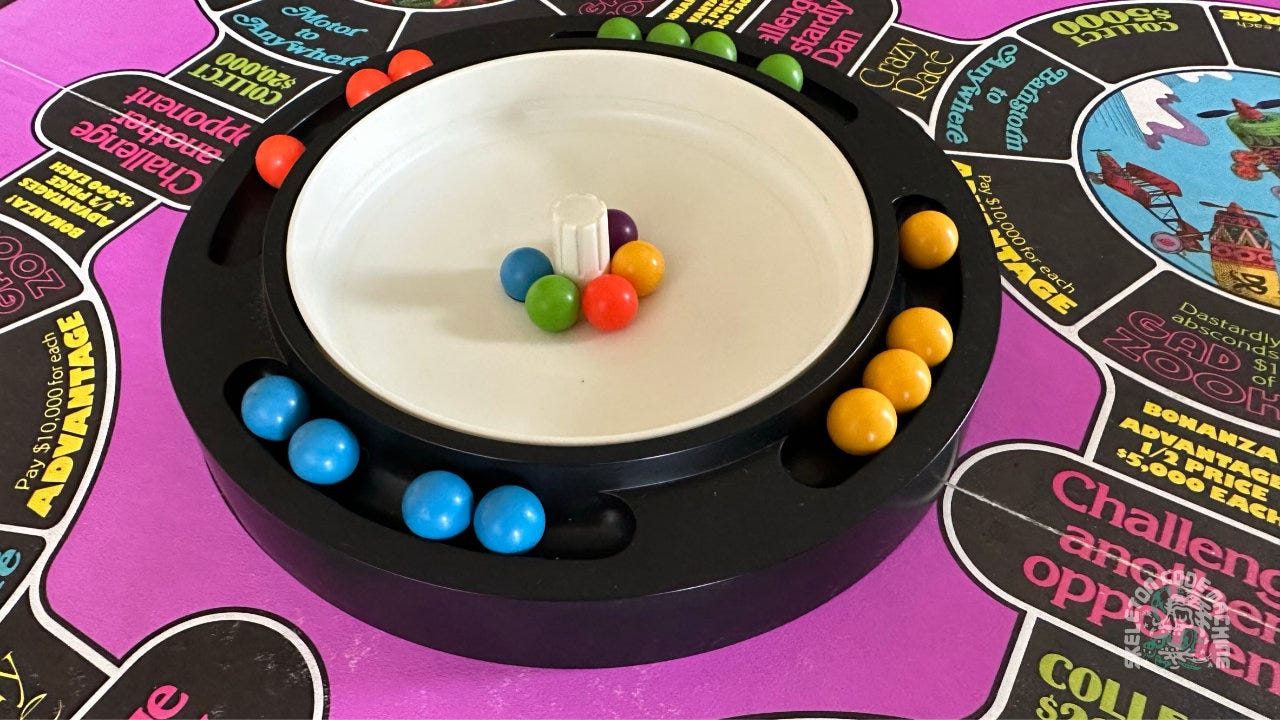The Magnificent Race
Spinning marbles and racing around the world in The Magnificent Race
A few weeks ago we looked at Dungeon Dice (Gruen, 1977), using Python to explore some of its mechanisms. This week we take a look The Magnificent Race (Cooke, 1975)!
The Magnificent Race
I was surprised to find that The Magnificent Race was designed by Bill Cooke, one of the two designers of Boggle (Cooke & Turoff, 1980)!
While Boggle continues to be sold today, The Magnificent Race has faded into obscurity over the last 48 years:
Pretend that you’re back at the turn of the century before anybody ever heard of the jet-set. You’ve got money and wherewithal to possess your own balloon, steamer, automobile and aeroplane. Just for kicks, you and three friends have decided to get together for a magnificent round the world race, beginning and ending in New York City. But as luck would have it… that rascal Dastardly Dan hears about the fun and he’s out to foil your plans.
Just like Dungeon Dice, this game has that wonderful 1970s cartoon art style that was so common at the time. Unfortunately the artist is uncredited. If you have any idea who the artist was, please comment below!
Roll and move
While the spinner is the flashy part, at its core The Magnificent Race is a roll and move game. You roll a six-sided die and move that many spaces.
As discussed in Board Game Barrage #287 (~30:36), tabletop game mechanisms can fall out of fashion. This has happened to roll and move, player elimination, and (to some extent) take that. Forty years ago, however, these were present in many of the Parker Brothers games.
Interestingly, The Magnificent Race modifies roll and move in two ways:
Directional pawns: The pawns are shaped like arrows which indicate direction. You can change your direction before you roll the die, adding at least a little player choice.
No fixed start/end: Unlike most roll and move games with fixed start and end points on the board, this allows free movement. There is no spot on the board for victory, instead it’s a mixture of upgrades and chances for races. The races are what win the game.
This allows players to have some agency when navigating the nine types of spaces, though not enough to avoid random and discouraging spaces like “Gad Zooks!” which steal $10,000 of your money.
Some well regarded games like Xia: Legends of a Drift System (Miller, 2004), Camel Up (Bogen, 2014), and Deep Sea Adventure (Sasaki & Sasaki, 2014) incorporate roll and move elements into their gameplay, but some modification and mitigation is included.
Spinning pool building
Races are resolved using a spinner with marbles (video).
Each player adds one marble, plus additional for Advantages collected for each of the various types of race (i.e. Balloon, Automobile, Steamer, Aeroplane), up to a maximum of five.
There’s always a purple marble, representing the non-player Dastardly Dan (not be be confused with Dick Dastardly) who acts as a spoiler. He can steal first place, and ends races early.
The spinner flings the marbles out to the edge, and is then stopped. The marbles swirl and the first one to land in the small divot near the center is the First Place (3 points) winner. That marble is removed, and it’s spun again for Second (2 points) and Third Place (1 point).
It’s fun, visually interesting, and exciting! It’s also an example of something like bag building (see also: Wonder Land’s War). While not the same thing, you are upgrading your types of race (e.g. Automobile) so that you have more chances in the pool/spinner to win. You could just as easily put the marbles in a bag and draw out the winners.
Chance of winning a race
It takes 26 points to win the game by moving your scoring marker from New York around the world and back to New York. A player could win First, Second, and Third Places in a single race if they had enough marbles (and luck), earning 6 points.
Assuming each of the marbles has an equal chance of landing in the divot and winning, the probability is easy to calculate. If you have two marbles vs. five other marbles, you have a 2:7 or ~29% chance of coming in first. No Python required!
While that isn’t particularly interesting, I do like how each winner is removed and the spinner is used again to determine Second and Third Place winners. Extra marbles don’t only increase your chance of winning individual races, they increase your chance of more points per race.
Conclusion
Some things to think about:
Rethink unfashionable mechanisms: I don’t believe mechanisms are ever “outdated” and should be discarded. Even ones like roll/spin and move can be used to great effect with some modification.
Flashy components work: While I clearly enjoy games that can be played with cards and dice, it’s hard to discount the impact of having a novelty component. The spinner and marbles are fun!
Non-player characters with personality: The personification of Dastardly Dan is an interesting choice, adding to the theme of the game and allowing for two player races. He even has his own pool of money that can be won via challenges.
Have you ever played The Magnificent Race or the similar (but not related) Wacky Races (Uncredited, 1969)? If so, please leave a comment about your experience!
Skeleton Code Machine is a production of Exeunt Press. If you want to see what else is happening at Exeunt Press, check out the Exeunt Omnes newsletter.
See you next week!
— E.P. 💀
P.S. Do you like MÖRK BORG? Check out #MÖRKTOBER starting October 1st! 🎃










That does it! You have not desisted from creating such informative, entertaining, and visually appealing game mechanics articles, so I am now forced to recommend you from my Substack! (Great article - keep 'em coming. 😁)
So much personality in the game's graphic design! It feels like the designers and publishers placed great empahasis on a great gaming experience.